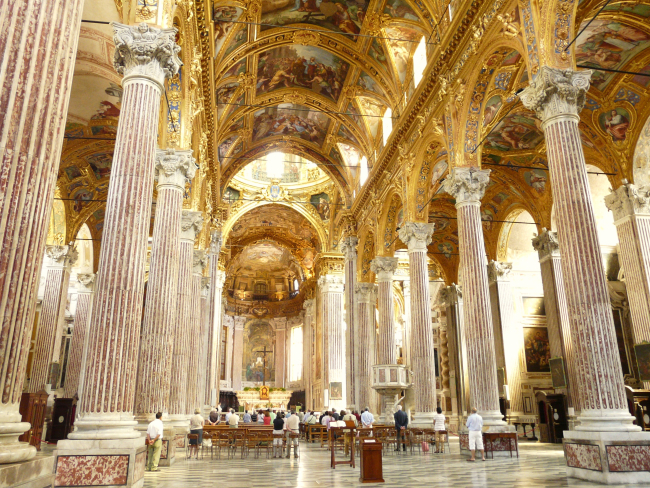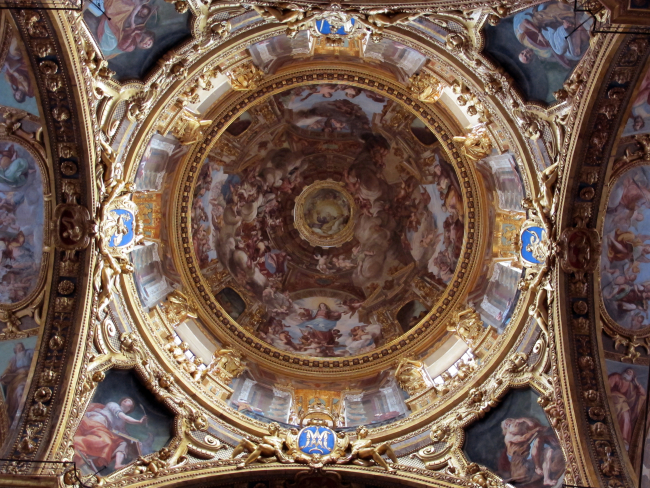Basilica della Santissima Annunziata del Vastato
Basilica della Santissima Annunziata del Vastato
“The church of the Annunziata is the most beautiful in Genoa... it's completely gilded...”
This is the endorsement the basilica of the Santissima Annunziata del Vastato earned in the mid-eighteenth century from a man not known for his effusive compliments, Montesquieu.
Even a chiaroscuro writer like Charles Dickens was enchanted by the fresh and graceful use of all that gold: “If you look up at the three Domes on a bright day, standing in front of the great altar, you are stunned by the glitter and the glory of the place… it is so finely painted and gilded that it looks like a large enamelled snuffbox.”
Visit
Waiting for the sun to shine, as Dickens advises, we savour the brilliant harmony between the fine gilding and the seventeenth-century frescoes by Giovanni & Giovan Battista Carlone and Gioacchino Assereto, the light as it moves along the wide naves playing with the polychrome marble inlays by Domenico Scorticone and Giacomo Porta.
The church houses great works of Genoese painting dating from late mannerism, baroque and the eighteenth century. Again Montesquieu informs us: “On the portal, inside, there is a very beautiful painting by Procaccini”, today we can enjoy the forty square meters of his Last Supper in all its original splendour, thanks to a recent major restoration.
For the cupola, Andrea Ansaldo created a complex perspective device, combining trompe-l'œil, frescoes and gold statuary, an important example of the splendour and theatricality of early seventeenth-century Genoese art.
In the naves and on the altars, a seemingly infinite series of great pictorial works by extraordinary artists including many from the Genoese school: Luca Cambiaso, Guercino, Bernardo Strozzi, Giulio Benso, Giovanni Battista Paggi, Domenico Piola, Gregorio De Ferrari, Andrea Semino, Giovanni Andrea De Ferrari, Pietro Paolo Raggi, Luciano Borzone, Aurelio Lomi, Giovan Battista Vicino, Nicolò Carlone, Domenico Fiasella, Vittorio Gatto, Octave Pellè, Bernardo Carbone, Sebastiano Galeotti, Anton Maria Piola, Calvi, Giovanni Andrea Carlone, Tommaso Clerici and Simone Barabino.
History
It is thought that the name Vastato (from guastum or vastinium, i.e. demolition) indicated the open spaces immediately outside the city walls, areas without trees or other cover for potential attackers, where Genoese crossbowmen went to practice.
The large tree free area was chosen by a community of “Humiliati” Friars to build their monastery and church, Santa Marta del Prato; the choice was also due to the presence of two rivers, now filled in, which allowed wool to be worked.
From the beginning of the sixteenth century, various branches of the Franciscan community succeeded each other in the Vastato complex (first the “Conventual” Friars, then the “Observant” Friars). The church underwent a rebuilding on dimensions that were large even for the period, the work proceeded intermittently until the end of the century. The Observant Franciscan Friars brought with them the name of their previous church: Santissima Annunziata.
The Council of Trent at the end of the sixteenth century an almost total renovation of the building was undertaken, to finance this patronage of the main chapel was sold to the Lomellini family. The church became first a family chapel and later a noble parish; taking on Baroque style, first under the guidance of Taddeo Carlone and then, from 1615, by Giovanni Domenico Casella (known as Scorticone) and Giacomo Porta. The buildings opposite were purchased and then demolished, so that the church was able to extend a “span and a half” (a span is the distance between two columns) outwards towards the current Piazza della Nunziata.
The neoclassical facade with two bell towers and a grandiose pronaos with six Ionic columns was built in 1867 to designs by Carlo Barabino reworked by Giovanni Battista Resasco.
Under the bombs of the Second World War, the church suffered a greatly, but the load-bearing structure held and only some “filling” structures collapsed, revealing the original medieval columns built of contrasting black and white cylindrical stone blocks (“drums”).





